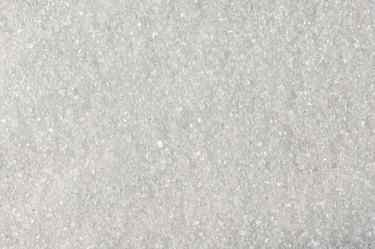
Sugar syrups flavor drinks, top pancakes and sweeten snow cones. They also illustrate a number of fascinating scientific principles such as supersaturation, crystallization and nucleation sites. You might find these scientific concepts less interesting when they ruin a batch of simple syrup you're making, though. While not all grainy sugar syrup can return to its smooth, fluid state, melting the sugar crystals often fixes a crystallized syrup.
Crystallization
Video of the Day
Rock candy gets its name because it closely resembles clear quartz or calcite. Like quartz, sugar forms crystals -- regular symmetrical shapes in predictable patterns -- when it solidifies or precipitates from solution undisturbed. For making certain types of candy, this crystallization process is essential to its texture. Other types of candy and sugar syrups require sugar in a noncrystalline, amorphous state. The graininess in your syrup is tiny crystals of sugar; to remove them, you must remelt the crystals.
Video of the Day
Reheating
Heating a solution allows it to hold more dissolved material. When you heat sugar syrup that has partially crystallized, the water in the syrup can contain more sugar, allowing the sugar crystals to dissolve. They must dissolve fully or, as the syrup cools, crystals will form again around the tiny seed crystals within the mixture. Because it's so important to dissolve every sugar crystal in the syrup, it's best to heat grainy syrup on the stove instead of the microwave. The microwave may not heat the syrup evenly, leaving some areas of the solution grainy and providing nucleation sites for more crystals to form. Heat the syrup on the stove without stirring -- the spoon could introduce nucleation sites, too -- until every trace of graininess disappears. Pour the mixture into a clean container and allow it to cool.
Corn Syrup
Corn syrup helps keep sugar syrup from crystallizing. The sugar in corn syrup is glucose, while sugar syrups contain sucrose. Although sucrose is half glucose and half fructose, the chemical bonds between the two simple sugars changes the chemical nature of the compound. Sodium and chlorine are both deadly in their pure state, but together they form sodium chloride -- harmless table salt. Like table salt, sugar has different characteristics than its component sugars. Glucose does not crystallize like sucrose, so it prevents sucrose in the solution from growing together to form grainy crystals. Because glucose remains fluid in solution, it acts as a lubricant, letting sucrose molecules slide past one another instead of adhering and forming the regular lattice-like structure of crystals. After melting a crystallized sugar syrup, add a teaspoon of corn syrup for every cup of sugar syrup to inhibit further crystal growth.
Acidic Ingredients
Sucrose consists of two simple sugars, fructose and glucose, bonded together. Acidic ingredients separate some of these larger sucrose molecules into their constituent sugars. As with adding corn syrup, adding acidic ingredients such as cream of tartar, vinegar or citrus juice introduces glucose to the solution and keeps crystals from forming as easily. While these tart additives keep your syrup pourable and smooth, use them sparingly to preserve the taste of the syrup.